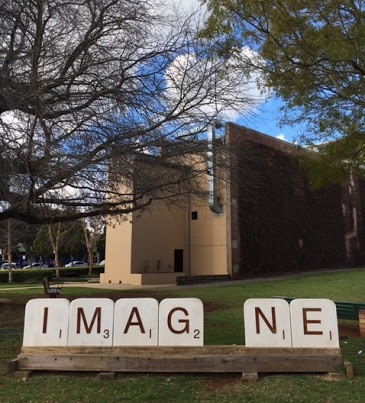How? Art. Toowoomba Region Libraries, Queensland Australia
A safe and inspiring library space requires the freedom to explore with no fear of wrong answers. Such a place should allow you to be yourself while welcoming others' ways too. What does that mean for children and young people in a regional Australian library service?
In the Toowoomba Region, Queensland, we looked at Story Time as a space for bringing philosophical – and practical – change to the library's ways of engaging with young patrons and their families.
How? Art.

Image: Imagine by Emma Anna 2014. Photographer Marta Cabral 2016
Toowoomba is increasingly known for its street art. Every year, local and international artists cover building walls with large scale murals all around the city, and that artwork becomes part of Toowoomba’s ever changing landscape. This happens during First Coat, a community festival where passers-by are invited to interact with the artists and share thoughts and ideas; the wall art becomes part of the city life. Over the years, we see the streets change as one artist after the other paints the city walls and share their unique vision.
We wanted to bring the spirit of street art and similar practices into the lives, habits, and control of even our youngest library patrons – starting way before they even read.
In 2015, the State Library of Queensland rolled out First 5 Forever, an early literacy initiative in approximately 320 public libraries across Queensland. This State Government, four year initiative targeting parents and carers of birth to five years, was the impetus to review Story Time across our library service. A literature review informed our underlying programming philosophy: that appropriate learning for the early years is that which allows for expression of personality and uniqueness, enhances dispositions such as curiosity and creativity and enables children to make connections between prior experience and new learning (Belonging, Being and Becoming. The Early Years Learning Framework for Australia 2009).
As a result of our evaluations, the Story Time program, learning activities and art initiatives have been adapted to help children under five take charge of the space, lead their own encounters with stories, and take ownership of their interactions as part of the library community.
Through open-ended explorations of everyday materials, we provided our staff with resources to challenge a product-driven, craft-based, prescriptive approach to art making. Instead of our goal being for kids to make “something pretty” that would look good on their carers’ Pinterest or Instagram account, we wanted young patrons to pursue experiences driven by their own interests and curiosities, in which results are not pre-determined and surprises are welcome. If the end product looked pretty for a social media audience, that was fine – but it wasn’t a prescribed goal. Art is not something you do as part of a program; it is a space you enter through a properly resourced and planned area of the library.
Within this space, we are not telling children what to do. We do not impose our interpretations of books or ask them to follow us in our ideas. We offer stories, experiences, and materials as inspiration for them to create their own art. Our role is simple to support them in those creations and explorations.
“Listening to materials” means paying close attention to their properties and possibilities as we are inspired to create with them. For example, when we look at a small box we can see beyond the breakfast cereal it original contained. If we listen, we will find specific textures, colors, shapes, lines, that may turn into new things as we interact with them.
Listening to materials makes us aware of the importance of listening to each other and to the community, too. We don't give children pre-cut shapes to position in a certain way – we give them colourful paper to play with as they see fit.
Embracing the unique process and products of each individual's art reminds us to welcome a diversity of experiences and ways of being. Trusting each child as a capable person who can take the lead on their own material explorations, we push ourselves to support the community in taking charge of their library in positive ways.
This is not necessarily a swift or simple process. Change does not happen overnight, and involves trial and error, negotiation, working around pre-conceived ideas about “pretty things” as the desired outcome of children’s art activities, and advocating for the benefits of this practices. This approach may look easier for preparation but it takes bravery to implement. Staff need to be trained in how to have open ended discussions to guide imagination, rather than copying a pre-prepared example. Mostly, it is important to learn how to show appreciation for all types of outcomes in art activities, and helping parents understand them as valuable even if they aren’t conventionally “pretty”.
More than a simple change in one individual program, this approach to Story Time reflects an evolution of the library’s relationship with the community. Our libraries’ offerings are increasingly participatory and patron-centered. This intentional programming ethos continues in other outreach activities that we have delivered this year including Fun Palaces and Kids Day Out. The Fun Palace event used everyday items, such as dirt, water, boxes, sand and buckets, to support open–ended activities in which children and their adults participated as equal partners. This event reflected the Early Years Learning Framework which has play based learning as its basis.
Starting from the ways we approach materials and art-making, we model a way of being in the library – and in the world – that puts everyone in charge of their own learning, as the capable individuals that they are.
Authors:
Marta Cabral – Adjunct Assistant Professor Columbia University Teachers College, Artist in Residence Rita Gold Early Childhood Center at Columbia University
Fiona Hjortshoj – First 5 Forever Project Officer, Toowoomba Region Libraries
Jo Beazley – Coordinator Programs and Services, Toowoomba Region Libraries